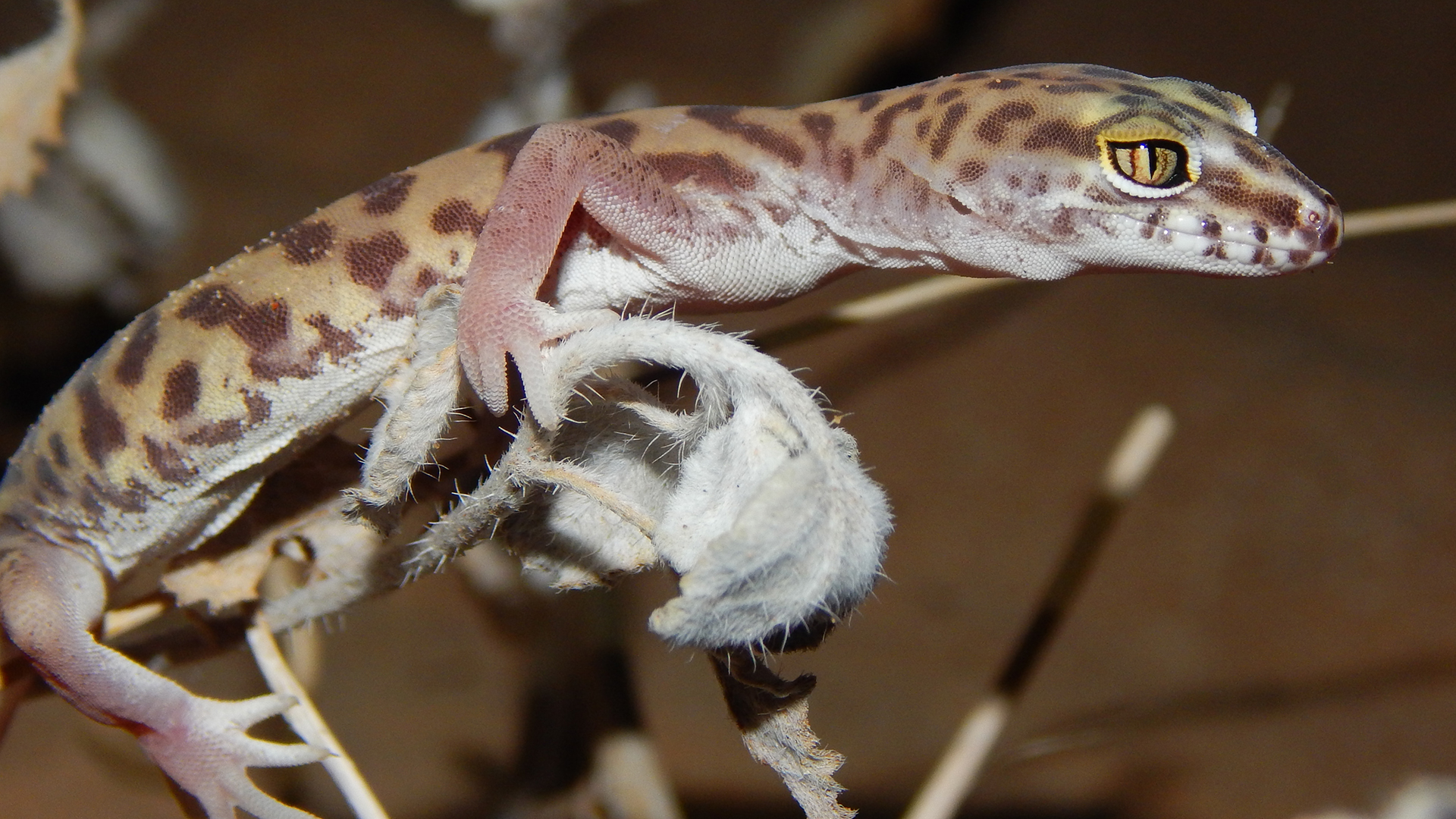'Berserker' geckos slam scorpions into oblivion before eating them, epic new footage shows
They whip their prey back and forth.

Geckos that are typically placid and mild-mannered become violent, head-shaking "berserkers" when subduing a scorpion meal, new research reveals.
When a western banded gecko (Coleonyx variegatus) bites down on its scorpion prey, it repeatedly whips its head from side to side, slamming the scorpion into the ground over and over again. The geckos are "the least intimidating animal you've probably ever met," lead author Malachi Whitford, who conducted the research as part of his doctoral degree in ecology at San Diego State University (SDSU), said in a statement. "But then they see a scorpion — they go like, berserker mode."
This violent approach may lend the gecko some protection from the venomous stingers of the scorpions, according to the new study.
Animals such as roadrunners, crocodiles and some mammalian carnivores are known to immobilize their prey through shaking, but this is the first detailed description of banded geckos shaking scorpions, Whitford told Live Science in an email.
Related: 6 crazy skills that prove geckos are amazing
Western banded geckos live in arid parts of western North America and measure about 4 to 6 inches (10 to 15 centimeters) long. The reptiles mostly eat insects but occasionally snack on dune scorpions (Smeringurus mesaensis).
Study co-author and SDSU biology professor (and Whitford's graduate advisor) Rulon Clark first observed the scorpion-smacking geckos in the 1990s, when he was an undergraduate research assistant working at a desert site near Yuma, Arizona. Whitford, now a professor of environmental science at Clovis Community College in Fresno, California, said that when the researchers decided to investigate this further, "it became very apparent that the geckos would readily perform the shaking behavior when presented with a scorpion."
Sign up for the Live Science daily newsletter now
Get the world’s most fascinating discoveries delivered straight to your inbox.
Once the shaking was done, the geckos would quickly swallow the scorpions in a few gulps, Whitford said. "The whole process was over in just a few seconds," he added.

The scientists filmed the geckos at 1,200 frames per second as the animals stalked and caught scorpions and non-venomous prey. They conducted 21 trials in which nine geckos were given scorpions to eat, and 10 trials in which eight geckos ate non-scorpion prey. Using digital tracking technology, the scientists mapped the geckos' head movements frame-by-frame, measuring variables such as velocity and acceleration as the geckos shook scorpions back and forth more than a dozen times in just a few seconds.
The geckos rotated their heads and bodies to and fro in a cyclical motion in order to smash the scorpions against the ground, the study found.
There are a few ways in which shaking scorpions could make them safer for the geckos to eat, the scientists said in the study. One possibility is that shaking immobilizes the scorpions; but only about 62% of the scorpions were immobile after being shaken.
Most of the geckos that were given scorpions — about 90% — were stung during their encounters, but it's possible that shaking the scorpions reduced the severity of their stings or prevented the scorpion from delivering a full payload of venom, according to the study. All the shaking and slamming could also be an attempt to fracture the scorpion's stinger.
"Given the speed and violence of shake-feeding, we suggest that geckos shake the scorpion to cause mass trauma and subsequent immobility or, potentially, to break the stinger and render the scorpion harmless," the researchers wrote.
More detailed observations of the geckos, using multiple camera angles and 3D modeling, could provide a clearer picture of how scorpions are affected by all that violent motion, the authors concluded.
"From our recordings, it was clear that the geckos were actively slamming the scorpions into the substrate. However, as we only have a top-down view of the shaking, we were unable to describe the forces being experienced by the scorpions," Whitford explained. "Ideally, the next step would be to study the shaking behavior using 3D videography."
The findings were published Jan. 5 in the Biological Journal of the Linnean Society.
Originally published on Live Science.

Mindy Weisberger is an editor at Scholastic and a former Live Science channel editor and senior writer. She has reported on general science, covering climate change, paleontology, biology and space. Mindy studied film at Columbia University; prior to Live Science she produced, wrote and directed media for the American Museum of Natural History in New York City. Her videos about dinosaurs, astrophysics, biodiversity and evolution appear in museums and science centers worldwide, earning awards such as the CINE Golden Eagle and the Communicator Award of Excellence. Her writing has also appeared in Scientific American, The Washington Post and How It Works Magazine. Her book "Rise of the Zombie Bugs: The Surprising Science of Parasitic Mind Control" will be published in spring 2025 by Johns Hopkins University Press.









